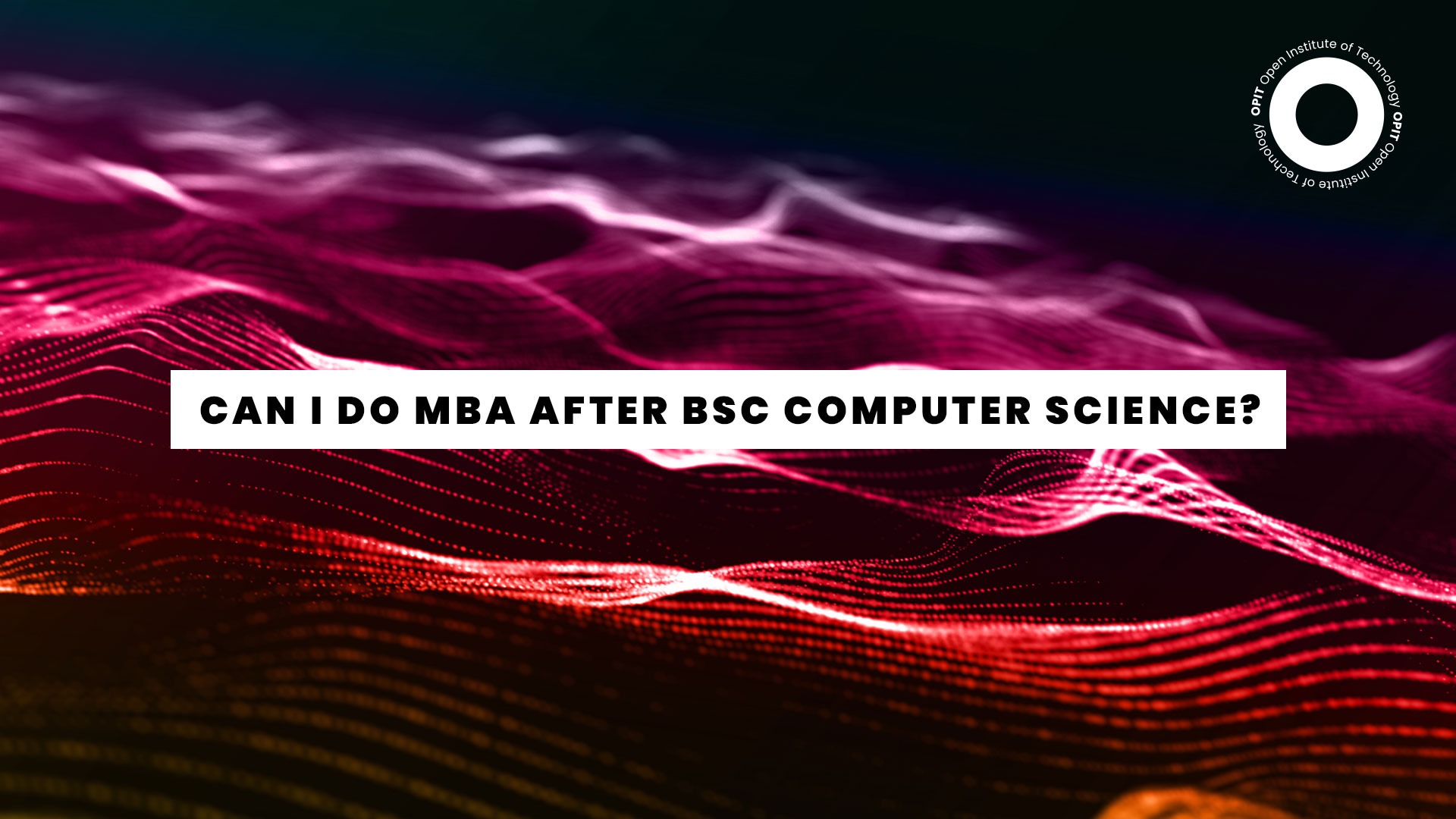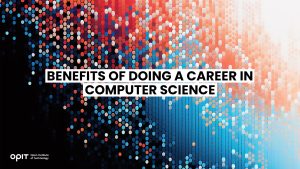

With your BSc in Computer Science achieved, you have a ton of technical knowledge in coding, systems architecture, and the general “whys” and “hows” of computing under your belt. Now, you face a dilemma, as you’re entering a field that over 150,000 people study for per year, meaning competition is rife.
That huge level of competition makes finding a new career difficult, as UK-based computer science graduates discovered in the mid-2010s when the saturation of the market led to an 11% unemployment rate. To counter that saturation, you may find the siren’s call of the business world tempts you toward continuing your studies to obtain an MBA.
So, the question is – can I do MBA after Computer Science?
This article offers the answers.
Understanding the MBA Degree
MBAs exist to equip students with the knowledge (both technical and practical) to succeed in the business world. For computer science graduates, that may mean giving them the networking and soft skills they need to turn their technical knowledge into career goldmines, or it could mean helping them to start their own companies in the computing field.
Most MBAs feature six core subjects:
- Finance – Focused on the numbers behind a business, this subject is all about learning how to balance profits, losses, and the general costs of running a business.
- Accounting – Building on the finance subject, accounting pulls students into the weeds when it comes to taxes, operating expenses, and running a healthy company.
- Leadership – Soft skills are just as important as hard skills to a business student, with leadership subjects focusing on how to inspire employees and foster teamwork.
- Economic Statistics – The subject that most closely relates to a computer science degree, economic statistics is all about processing, collecting, and interpreting technical data.
- Accountability/Ethics – With so many fields having strict compliance criteria (coupled with the ethical conundrums that arise in any business), this subject helps students navigate potential legal and ethical minefields.
- Marketing – Having a great product or service doesn’t always lead to business success. Marketing covers what you do to get what you have to offer into the public eye.
Beyond the six core subjects, many MBAs offer students an opportunity to specialize via additional courses in the areas that interest them most. For instance, you could take courses in entrepreneurship to bolster your leadership skills and ethical knowledge, or focus on accounting if you’re more interested in the behind-the-scenes workings of the business world.
As for career opportunities, you have a ton of paths you can follow (with your computer science degree offering more specialized career routes). Those with an MBA alone have options in the finance, executive management, and consulting fields, with more specialized roles in IT management available to those with computer science backgrounds.
Eligibility for MBA After BSc Computer Science
MBAs are attractive to prospective post-graduate students because they have fairly loose requirements, at least when compared to more specialized further studies. Most MBA courses require the following before they’ll accept a student:
- A Bachelor’s degree in any subject, as long as that degree comes from a recognized educational institution
- English language proficiency
- This is often tested using either the TOEFL or IELTS tests
- A pair of recommendation letters, which can come from employers or past teachers
- Your statement of purpose defining why you want to study for an MBA
- A resume
- A Graduate Management Admissions Test (GMAT) score
- You’ll receive a score between 200 and 800, with the aim being to exceed the average of 574.51
Interestingly, some universities offer MBAs in Computer Science, which are the ideal transitional courses for those who are wary of making the jump from a more technical field into something business-focused. Course requirements are similar to those for a standard MBA, though some universities also like to see that you have a couple of years of work experience before you apply.
Benefits of Pursuing an MBA After BSc Computer Science
So, the answer to “Can I do MBA after BSc Computer Science,” is a resounding “yes,” but we still haven’t confronted why that’s a good choice. Here are five reasons:
- Diversify your skill set – While your skill set after completing a computer science degree is extremely technical, you may not have many of the soft skills needed to operate in a business environment. Beyond teaching leadership, management, and teamwork, a good MBA program also helps you get to grips with the numbers behind a business.
- Expand career opportunities – There is no shortage of potential roles for computer science graduates, though the previously mentioned study data shows there are many thousands of people studying the same subject. With an MBA to complement your knowledge of computers, you open the door to career opportunities in management fields that would otherwise not be open to you.
- Enhance leadership and management skills – Computer science can often feel like a solitary pursuit, as you spend more time behind a keyboard than you do interacting with others. MBAs are great for those who need a helping hand with their communication skills. Plus, they’re ideal for teaching the organizational aspects of running (or managing) a business.
- Potential for higher salary and career growth – According to Indeed, the average salary in the computer science field is $103,719. Figures from Seattle University suggest those with MBAs can far exceed that average, with the figures it quotes from the industry journal Poets and Quants suggesting an average MBA salary of $140,924.
Challenges and Considerations
As loose as the academic requirements for being accepted to an MBA may be (at least compared to other subjects), there are still challenges to confront as a computer science graduate or student.
- The time and financial investments – Forbes reports the average cost of an MBA in the United States to be $61,800. When added to the cost of your BSc in Computer Science, it’s possible you’ll face near-six-figure debt upon graduating. Couple that monetary investment with the time taken to get your MBA (it’s a full-time course) and you may have to put more into your studies than you think.
- Balancing your technical and managerial skills – Computer science focuses on the technical side, which is only one part of an MBA. While the skills you have will come to the fore when you study accounting or economic statistics, the people-focused aspects of an MBA may be a challenge.
- Adjusting to a new academic environment – You’re switching focus from the computer screen to a more classroom-led learning environment. Some may find this a challenge, particularly if they appreciate the less social aspects of computer science.
MBA Over Science – The Thomas Henson Story
After completing his Bachelor’s degree in computer information systems, Thomas Henson faced a choice – start a Master’s degree in science or study for his MBA. Having worked as a software engineer for six months following his graduation, he wanted to act fast to get his Masters’s done and dusted, opening up new career opportunities in the process.
Eventually, he chose an MBA and now works as a senior software engineer specializing in the Hortonworks Data Platform. On his personal blog, he shares why he chose an MBA over a Master’s degree in computer science, with his insights possibly helping others make their own choice:
- Listen to the people around you (especially teachers and mentors) and ask them why they’ve chosen their career and study paths.
- Compare programs (both comparing MBAs against one another and comparing MBAs to other post-graduate degrees) to see which courses serve your future ambitions best.
- Follow your passion (James loved accounting) as the most important thing is not necessarily the post-graduate course you take. The most important thing is that you finish.
Choosing the Right MBA Program
Finding the right MBA program means taking several factors into consideration, with the following four being the most important:
- Reputation and accreditation – The reputation of the institution you choose, as well as the accreditation it holds, plays a huge role in your decision. Think of your MBA as a recommendation. That recommendation doesn’t mean much if it comes from a random person in the street (i.e., an institution nobody knows), but it carries a lot of weight if it comes from somebody respected.
- Curriculum and specialization – As Thomas Henson points out, what drives you most is what will lead you to the right MBA. In his case, he loved accounting enough to make an MBA a possibility, and likely pursued specializations in that area. Ask yourself what you specifically aim to achieve with your MBA and look for courses that move you closer to that goal.
- Networking opportunities – As anybody in the business world will tell you, who you know is often as important as what you know. Look for a course that features respected lecturers and professors, as they have connections that you can exploit, and take advantage of any opportunities to go to networking events or join professional associations.
- Financial aid and scholarships – Your access to financial aid depends on your current financial position, meaning it isn’t always available. Scholarships may be more accessible, with major institutions like Harvard and Columbia Business School offering pathways into their courses for those who meet their scholarship requirements.
Speaking of Harvard and Columbia, it’s also a good idea to research some of the top business schools, especially given that the reputation of your school is as important as the degree you earn. Major players, at least in the United States, include:
- Harvard Business School
- Columbia Business School
- Wharton School of Business
- Yale School of Management
- Stanford Graduate School of Business
Become a Business-Minded Computer Buff
With the technical skills you earned from your BSc in Computer Science, you’ll be happy to find that the answer to “Can I do MBA after BSc Computer Science?” is “Yes.” Furthermore, it’s recommended as an MBA can equip you with soft skills, such as communication and leadership, that you may not receive from your computing studies. Ultimately, the combination of tech-centric and business skills opens the door to new career paths, with the average earnings of an MBA student outclassing those of computer science graduates.
Your choice comes down to your passion and the career you wish to pursue. If management doesn’t appeal to you, an MBA is likely a waste of time (and over $60,000), whereas those who want to apply their tech skills to the business world will get a lot more out of an MBA.
Related posts

Life is unpredictable. While many of us have specific hopes and expectations of how our futures will turn out, things don’t always go as expected. There are many variables and unexpected incidents that can interfere and force you to alter your plans, and this is particularly true when it comes to education.
For instance, you might have had plans to study a specific subject, but had to deviate from those plans due to unforeseen circumstances. Or you may have had to enter the workforce in an occupation different from the one you sought in an effort to earn an income, a move that may not provide you with the time or opportunity to achieve your desired educational aims.
In short, every individual’s career pathway is different, and very few go exactly as we expect from the outset. Fortunately, even if you experience a few false starts or sudden twists in your pathway, there are always options available to help you get back on track.
The Unpredictable Nature of Education
In theory, the educational process seems simple. You select a course of study that interests you from the vast array of subjects and prospective professions, select the appropriate classes, acquire the knowledge and skills you need to succeed, and then embark on your profession.
In reality, however, as many people know from firsthand experience, the road to education is often far from straightforward. Here are just some of the many challenges that can take your educational path in a completely different direction:
- Life’s Curveballs: As touched on in the introduction, life is impossible to predict. Financial hardships, health issues, and family emergencies are just some of the unfortunate occurrences that might derail even the most perfectly planned educational regime.
- Changing Interests: People’s desires and preferences don’t necessarily stay the same throughout their entire lives. As you grow, learn, and have new experiences, your interests may change, and so, too, may your educational objectives.
- Pressure and Burnout: Some academic paths are particularly challenging, demanding intense levels of study and hard work. This can sometimes prove too much to bear, even for the most resilient students.
- Failures and Setbacks: Conventional education largely builds around tests and examinations, requiring students to demonstrate their competencies repeatedly. It’s a system that doesn’t suit everyone, and test failures can lead to setbacks and delays.
- Inequality: People can be born with very different privileges and levels of access to education. Those in certain parts of the world may find it much more challenging to complete their education path for financial, cultural, or even political reasons.
- Late Bloomers: People develop at different paces. Some may struggle educationally early on in their lives, forcing them to make certain concessions or sacrifices related to their studies, only to find their feet later in life once they’ve entered the world of work.
Whether you’re a late bloomer, have had your educational aspirations delayed by personal problems, desire to learn new skills and try something different, or want to begin a fresh chapter in your professional life, the Open Institute of Technology (OPIT) may be able to help.
Introducing OPIT
OPIT is an online teaching platform, making high-level technological educational programs accessible to all, no matter their age or background. Offering education in fields like computer science, artificial intelligence, and digital business, OPIT provides a curated collection of degrees. In addition, they offer classes taught by world-leading tutors imparting the wisdom and skills students need to achieve their goals and become the tech leaders of tomorrow.
Meanwhile, for those who have had somewhat tumultuous or unpredictable educational paths, OPIT offers the perfect course corrector: the OPIT Foundation Year.
The OPIT Foundation Year
OPIT’s Foundation Year is a Pre-Tertiary Certificate in Information Technology, fully aligned with MQF/EQF Level 4 standards and valued at 60 ECTS credits. Lasting just one year, this program essentially serves as a comprehensive yet accessible springboard towards higher-level education, creating a path towards degrees and careers in dynamic, flexible fields, like computer science and digital business.
Like other OPIT programs, the Foundation Year is delivered entirely online via the OPIT Virtual Learning Environment. Combining live lectures, asynchronous content, and interactive assessments, students enjoy diverse and dynamic study experiences, acquiring core skills like academic writing, mathematics, and computer literacy, and building a bedrock of knowledge and confidence before taking their next steps.
Who Is the Foundation Program For?
The Foundation Program is designed to provide a solid base upon which to build the technological education many students need. It’s the perfect choice for those who are eager and ambitious to enter professions in AI, data science, and computing, but don’t feel that they have the necessary core skills and knowledge needed to dive straight into a degree.
Entry requirements are relatively relaxed in order to allow as many students as possible to enjoy the benefits of this program. With that said, applicants should ideally hold an MQF/EQF Level 3 or equivalent qualification, with the intention of pursuing a bachelor’s degree. A minimum of B2 level of English proficiency is also required, as this is the working and studying language of the institution.
What the Foundation Year Provides
Perhaps you’ve recently graduated, are considering a career change, or finally have the opportunity to return to education after initial delays or unexpected disruptions to your original plans. Either way, the Foundation Year can help you enjoy:
- Greater Self-Confidence: Foundation Year graduates gain the fundamental skills they need to enter degree programs with much more self-belief and assuredness.
- Superior Tech Knowledge: Lasting two terms, this course explores mathematics, academic reading and writing, and provides an introduction to computer hardware and software.
- Foundational Mathematics: Mathematics literacy forms a large part of the study focus for the Foundation Year, helping students feel more comfortable with numbers and formulas.
- Flexible Learning: Unlike more rigid, conventional education environments, OPIT gives you the freedom and flexibility to study at a pace that suits you best, all from the comfort of home.
- Global Community: OPIT is an international institution, with staff and students from all around the world eager to share knowledge, exchange ideas, and help one another.
Take Your Next Steps to Success With the OPIT Foundation Year
If you’re curious about a career in technology or have always wanted to work with AI, data, and computers, but struggled to find the time and opportunities you need to acquire relevant skills and knowledge, the Foundation Program was made for people like you.
It’s the ideal entry point into the exciting world of online education, and the perfect first step towards a prestigious degree from an innovative and increasingly successful institution. Download the brochure to learn more about it, or start your online application, today.

Students today have a broader range of fields of study to choose from than ever before, but with the world becoming increasingly technological and computers increasing in influence and importance, pursuing a career in computer science often proves a smart, strategic choice.
There are numerous benefits and career paths associated with studying and working in computer science, and we’ll be listing just a few of them in this guide.
High Average Salaries
With the rising cost of living in many parts of the world, it’s unsurprising that many students are thinking several decades ahead to determine what level of starting salaries they could obtain in different career fields.
Many are also seeking professions that offer the opportunity for growth and the ability to advance up the ranks over time, thus increasing their salary and their quality of life in the process.
If a strong, stable salary with the opportunity for improved income is one of your top career priorities, computer science should be at or near the top of your list of prospective careers.
According to recent data, computer scientists earn an average of over €65,000 per year, with certain jobs, like IT project leader and data scientist, paying ever higher. Starting salaries are strong, too, with graduates earning anywhere from €46,000 to €60,000, depending on their chosen profession and level of qualifications.
There are similarly high average salaries reported around the world in computer science and related fields such as data science and AI/ML engineering. These numbers are projected to increase in the years to come, pointing to computer science as a way for graduates to get off to the best financial start of any career.
Unrivaled Flexibility
A common problem with some subjects and courses is that they only provide graduates with a narrow set of skills and a similarly narrow range of potential professions to which they can apply those skills.
That’s not the case with computer science. Graduates in this field can enjoy instant access to a remarkably diverse array of career opportunities, with even newer opportunities being created all the time as technology evolves and innovations emerge.
A few of the many industries and roles you might choose to enter in the field of computer science include:
- Healthcare: As a software developer, data analyst, or cybersecurity expert
- Finance: As a fintech engineer, blockchain developer, or security analyst
- Media: As a graphics programmer, AI developer, or game developer
- Education: As an analyst, software developer, or machine learning engineer
Guaranteed Opportunities
Some career paths are more limited than others, with relatively low numbers of opportunities, recurring risks of job loss, or difficulty obtaining employment in the first place.
Again, with computer science, this simply isn’t the case. At a time when 75% of companies plan to embrace AI and other technologies by 2027, and businesses of all sizes and industries are now relying on computers more than ever before, computer science graduates can enjoy almost unbeatable job security.
Opportunities will continue to grow for people with good computing knowledge, whether that be in the obvious fields like software and web development, engineering, and AI development, or more niche sectors.
With so many options, you’re effectively guaranteed a long, rewarding career if you put in the necessary time and effort needed to establish a strong foundation of computing skills.
Rapidly Expanding and Evolving Industries
It’s no secret that the world of technology is a dynamic and fast-moving one. In the past 20 years alone, we’ve seen the proliferation of the internet, the rapid advancement of smartphones and wearable devices, the emergence of AI, and so much more.
In the years ahead, engineers and developers will continue to explore the boundaries of modern technology’s powers and potential, driving new innovations and improvements and opening more exciting job opportunities for those already established and experienced in this field.
Getting into computer science now could therefore provide a solid foundation for a career filled with excitement as you uncover and explore new ways of working with computers in fields as diverse as healthcare, finance, education, entertainment, manufacturing, logistics, and beyond.
Start Your Computer Science Career at OPIT
We’ve discussed some of the many benefits associated with careers in computer science, from the high starting salaries to the rapidly growing array of job options available to graduates. By now, you may be eager to follow this particular career path and take advantage of the wealth of opportunities.
If you’re wondering how to start, the Open Institute of Technology (OPIT) may hold the answers you need. As an exclusively online learning platform, specializing in computer science and digital business, and staffed by some of the world’s leading tech experts, OPIT is producing the tech leaders of tomorrow.
Some of the many advantages of learning with OPIT include:
- Accessible and flexible online education that matches your learning style and schedule
- Heavy focus on real-world applications of the skills you acquire
- An international community of like-minded students from around the globe
- A top team of tutors and lecturers from varying fields and industries
- Progressive assessment of skills and understanding – not constant exams
OPIT offers a small, curated selection of courses for those seeking to gain the technological skills and knowledge to succeed in their chosen areas of expertise. That includes a BSc (Hons) in Computer Science – a six-term program, worth 180 ECTS credits.
Numerous IT industry leaders and experts helped develop this fully accredited undergraduate degree, which is online and accessible to all. Like other OPIT courses, it offers a flexible learning program, with progressive assessments, fast-track options, and the opportunity to be part of a growing community of learners and tutors.
If the benefits of doing a career in computer science interest you, download the OPIT BSc in Computer Science brochure or fill out an online application today and take your first step toward a rewarding and fulfilling profession.
Have questions?
Visit our FAQ page or get in touch with us!
Write us at +39 335 576 0263
Get in touch at hello@opit.com
Talk to one of our Study Advisors
We are international
We can speak in:


